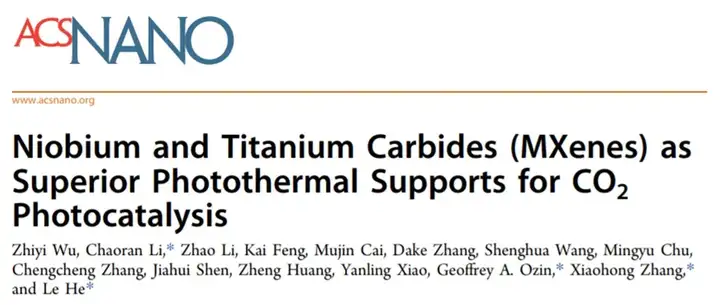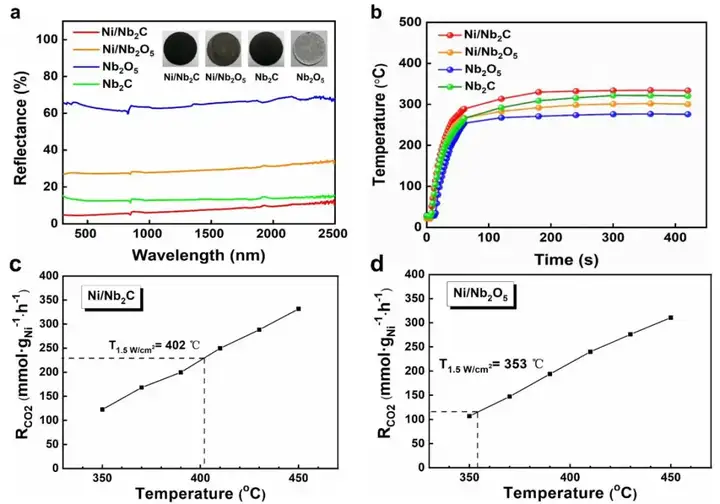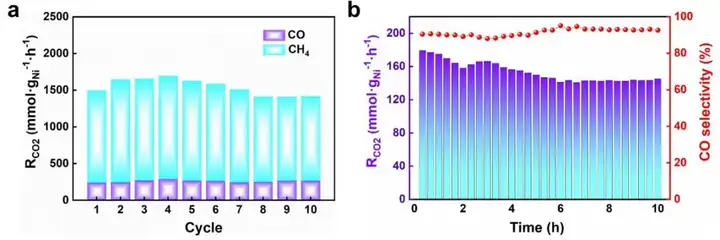Soochow University & University of Toronto, Canada ACS Nano research paper: Niobium carbide and titanium carbide MXenes materials as excellent photothermal carbon dioxide reduction catalyst supports

Article information
Niobium carbide and titanium carbide MXenes as excellent photothermal carbon dioxide reduction catalyst carrier First author: Wu Zhiyi Corresponding author: He Le*, Zhang Xiaohong*, Geoffrey A. Ozin*, Li Chaoran* Unit: Soochow University, University of Toronto, Canada
Research Background
In response to the bottleneck challenge of traditional photocatalytic carbon dioxide reduction in solar light utilization efficiency, scientists have recently proposed a new idea of photothermal catalysis. This process uses both the photochemical and photothermal effects of the catalyst to broaden the utilization efficiency of the solar spectrum. It is expected to realize high-efficiency photo-chemical energy conversion. Looking for photocatalysts with excellent light-to-heat conversion performance and building a high-efficiency photo-thermal catalysis system are still the frontiers and hotspots in this field. In this research work, we first explored the application potential of MXene materials with excellent light absorption and photothermal properties in photothermal catalysis. It is found that MXene material is an excellent photothermal catalyst carrier, which can not only disperse and stabilize active metal nanoparticles, but also improve the light utilization efficiency of metal nanocatalysts and greatly enhance the performance of photothermal catalysis. This work opens up new applications of MXene materials in the field of photothermal catalytic carbon dioxide reduction, and provides new ideas for constructing efficient photothermal catalytic systems.
Article Introduction
With the support of key international (regional) cooperation projects of the National Natural Science Foundation of China, Professor Zhang Xiaohong, Professor He Le, and Associate Researcher Li Chaoran from Soochow University collaborated with the team of Professor Geoffrey A. Ozin from the University of Toronto in Canada. Published an article entitled "Niobium and Titanium Carbides (MXenes) as Superior Photothermal Supports for CO2 Photocatalysis". The article reported for the first time the new application of MXene as a photothermal catalyst carrier. It was discovered that MXene material can not only effectively disperse and stabilize metal nanoparticles, but also enhance the photothermal catalytic activity of metal nanoparticles, revealing the role of MXene material in photothermal catalysis. Huge potential.
Highlights of this article
Key point 1: Nb2C MXene has excellent photothermal performance, but poor photothermal catalytic CO2 hydrogenation performance. A small layer of niobium carbide material is synthesized by the traditional etching-stripping method (Figure 1a-d), although it has excellent light absorption And photothermal performance, but its own H2 and CO2 activation ability is very poor, not suitable as a single-component photothermal catalyst (Figure 1e, f).
Niobium carbide and titanium carbide MXenes as excellent photothermal carbon dioxide reduction catalyst carrier First author: Wu Zhiyi Corresponding author: He Le*, Zhang Xiaohong*, Geoffrey A. Ozin*, Li Chaoran* Unit: Soochow University, University of Toronto, Canada
Research Background
In response to the bottleneck challenge of traditional photocatalytic carbon dioxide reduction in solar light utilization efficiency, scientists have recently proposed a new idea of photothermal catalysis. This process uses both the photochemical and photothermal effects of the catalyst to broaden the utilization efficiency of the solar spectrum. It is expected to realize high-efficiency photo-chemical energy conversion. Looking for photocatalysts with excellent light-to-heat conversion performance and building a high-efficiency photo-thermal catalysis system are still the frontiers and hotspots in this field. In this research work, we first explored the application potential of MXene materials with excellent light absorption and photothermal properties in photothermal catalysis. It is found that MXene material is an excellent photothermal catalyst carrier, which can not only disperse and stabilize active metal nanoparticles, but also improve the light utilization efficiency of metal nanocatalysts and greatly enhance the performance of photothermal catalysis. This work opens up new applications of MXene materials in the field of photothermal catalytic carbon dioxide reduction, and provides new ideas for constructing efficient photothermal catalytic systems.
Article Introduction
With the support of key international (regional) cooperation projects of the National Natural Science Foundation of China, Professor Zhang Xiaohong, Professor He Le, and Associate Researcher Li Chaoran from Soochow University collaborated with the team of Professor Geoffrey A. Ozin from the University of Toronto in Canada. Published an article entitled "Niobium and Titanium Carbides (MXenes) as Superior Photothermal Supports for CO2 Photocatalysis". The article reported for the first time the new application of MXene as a photothermal catalyst carrier. It was discovered that MXene material can not only effectively disperse and stabilize metal nanoparticles, but also enhance the photothermal catalytic activity of metal nanoparticles, revealing the role of MXene material in photothermal catalysis. Huge potential.
Highlights of this article
Key point 1: Nb2C MXene has excellent photothermal performance, but poor photothermal catalytic CO2 hydrogenation performance. A small layer of niobium carbide material is synthesized by the traditional etching-stripping method (Figure 1a-d), although it has excellent light absorption And photothermal performance, but its own H2 and CO2 activation ability is very poor, not suitable as a single-component photothermal catalyst (Figure 1e, f).

Figure 1. (a) Schematic diagram of the preparation process of few-layer niobium carbide nanosheets (fl-Nb2C). (b) Nb2AlC precursor, XRD pattern of multilayer Nb2C and few-layer Nb2C two-dimensional flake materials after Al layer etching. (C) TEM image of a few-layer Nb2C two-dimensional sheet material. (D) AFM image of a few-layer Nb2C two-dimensional sheet material. (E) Photothermal catalytic carbon dioxide hydrogenation performance graph of few-layer Nb2C. (F) The thermocatalytic performance graph of few-layer Nb2C under different temperature gradient conditions
Point 2: MXene carrier improves the photothermal catalytic activity of nickel nanoparticles. Considering the excellent light absorption and photothermal conversion performance of Nb2C MXene, we tried to use it as a carrier to support Ni nanoparticles to build a photothermal catalyst. Under the same conditions, compared with Nb2O5 loaded Ni nanoparticles (Ni/Nb2O5), the photothermal catalytic activity of Nb2C loaded Ni nanoparticles (Ni/Nb2C) increased by 5.3 times (Table 1). Under 36 solar intensities, the photothermal CO2 conversion rate of Ni/Nb2C reached a record 8.50 mol·gNi-1·h-1. Table 1. Comparison of photothermal catalytic performance of Ni/Nb2C and Ni/Nb2O5
Point 2: MXene carrier improves the photothermal catalytic activity of nickel nanoparticles. Considering the excellent light absorption and photothermal conversion performance of Nb2C MXene, we tried to use it as a carrier to support Ni nanoparticles to build a photothermal catalyst. Under the same conditions, compared with Nb2O5 loaded Ni nanoparticles (Ni/Nb2O5), the photothermal catalytic activity of Nb2C loaded Ni nanoparticles (Ni/Nb2C) increased by 5.3 times (Table 1). Under 36 solar intensities, the photothermal CO2 conversion rate of Ni/Nb2C reached a record 8.50 mol·gNi-1·h-1. Table 1. Comparison of photothermal catalytic performance of Ni/Nb2C and Ni/Nb2O5

Point 3: Nb2C carrier improves the photothermal conversion performance of Ni nanoparticles
Diffuse reflectance spectroscopy shows that the Nb2C supported Ni catalyst has better light absorption performance. The surface temperature and equivalent working temperature of different catalysts were tested under the same irradiation conditions, which confirmed that the main reason for the increase in photothermal catalytic activity is that the Nb2C carrier improves the Ni nanoparticles. The light-to-heat conversion performance (Figure 2).
Diffuse reflectance spectroscopy shows that the Nb2C supported Ni catalyst has better light absorption performance. The surface temperature and equivalent working temperature of different catalysts were tested under the same irradiation conditions, which confirmed that the main reason for the increase in photothermal catalytic activity is that the Nb2C carrier improves the Ni nanoparticles. The light-to-heat conversion performance (Figure 2).

Figure 2. (a) Ni/Nb2C, Ni/Nb2O5, Nb2C and Nb2O5 diffuse reflectance spectra of ultraviolet-visible-near-infrared. (b) Ni/Nb2C, Ni/Nb2O5, Nb2C and Nb2O5 catalyst surface temperature. (C) The equivalent working temperature of Ni/Nb2C under 15 sun irradiation. (D) Equivalent working temperature of Ni/Nb2O5 under 15 sun irradiation
Key point 4: Ni nanoparticle catalyst supported by Nb2C exhibits excellent stability. Ni/Nb2C still maintains stable photothermal and thermocatalytic performance under long-term working conditions, and the size of the Ni nanoparticle after the reaction remains basically unchanged. Prove that it has good stability. The Ti3C2 carrier also showed similar photothermal enhancement and stabilization effects, further confirming the great potential of MXene carrier in photothermal catalysis.
Key point 4: Ni nanoparticle catalyst supported by Nb2C exhibits excellent stability. Ni/Nb2C still maintains stable photothermal and thermocatalytic performance under long-term working conditions, and the size of the Ni nanoparticle after the reaction remains basically unchanged. Prove that it has good stability. The Ti3C2 carrier also showed similar photothermal enhancement and stabilization effects, further confirming the great potential of MXene carrier in photothermal catalysis.

Figure 3. (a) Ni/Nb2C stationary phase photothermal catalytic stability test results (test conditions: 10 cycles, 20 minutes each cycle). (b) Ni/Nb2C mobile phase thermocatalytic stability test results (test conditions: 400 °C, no light, 10 h)
Article information
Niobium and Titanium Carbides (MXenes) as Superior Photothermal Supports for CO2 Photocatalysishttps://pubs.acs.org/doi/abs/10.1021/acsnano.1c00990
Introduction of the research group
The leader of the Chinese research team is Professor Zhang Xiaohong. He is currently a professor, doctoral supervisor, vice president of Soochow University, and executive deputy director of the "Suzhou Nanotechnology Collaborative Innovation Center" of the Ministry of Education. He is the winner of the National Outstanding Youth Fund and the National "Ten Thousand Talents Program" for technological innovation. Leading talent, chief scientist of the National Major Research Project (973), project leader of the Innovative Research Group of the National Foundation of China, and recipient of special government allowances from the State Council. The team is mainly engaged in the research of new optical functional materials, focusing on the energy conversion-oriented organic and nano-semiconductor materials, including: (1) electricity → light energy conversion materials and devices (2) light → electricity energy conversion materials and devices (3) light →Chemical energy conversion materials and devices, photocatalysis and optical storage devices
Research Group Recruitment
According to the development needs of the research group, it is planned to recruit 1-2 post-doctoral researchers engaged in gas-phase photocatalytic carbon dioxide reduction research. Applicants in the research field of heterogeneous catalysis are preferred. The remuneration is good, and there is the opportunity to jointly train in well-known foreign research groups. Interested parties please send your resume to lehe@suda.edu.cn.
This information is sourced from the Internet for academic exchanges only. If there is any infringement, please contact us to delete it immediately.
Article information
Niobium and Titanium Carbides (MXenes) as Superior Photothermal Supports for CO2 Photocatalysishttps://pubs.acs.org/doi/abs/10.1021/acsnano.1c00990
Introduction of the research group
The leader of the Chinese research team is Professor Zhang Xiaohong. He is currently a professor, doctoral supervisor, vice president of Soochow University, and executive deputy director of the "Suzhou Nanotechnology Collaborative Innovation Center" of the Ministry of Education. He is the winner of the National Outstanding Youth Fund and the National "Ten Thousand Talents Program" for technological innovation. Leading talent, chief scientist of the National Major Research Project (973), project leader of the Innovative Research Group of the National Foundation of China, and recipient of special government allowances from the State Council. The team is mainly engaged in the research of new optical functional materials, focusing on the energy conversion-oriented organic and nano-semiconductor materials, including: (1) electricity → light energy conversion materials and devices (2) light → electricity energy conversion materials and devices (3) light →Chemical energy conversion materials and devices, photocatalysis and optical storage devices
Research Group Recruitment
According to the development needs of the research group, it is planned to recruit 1-2 post-doctoral researchers engaged in gas-phase photocatalytic carbon dioxide reduction research. Applicants in the research field of heterogeneous catalysis are preferred. The remuneration is good, and there is the opportunity to jointly train in well-known foreign research groups. Interested parties please send your resume to lehe@suda.edu.cn.
This information is sourced from the Internet for academic exchanges only. If there is any infringement, please contact us to delete it immediately.
18915694570
Previous: Professor Chunyi Zhi,


